The Role of Cement Additives in Modern Construction
Cement additives are essential materials that enhance the performance and properties of cement in the construction industry. As construction techniques evolve and the demand for high-performance materials increases, the significance of these additives cannot be overstated. This article explores the various types of cement additives, their functions, and their impact on construction practices.
Types of Cement Additives
Cement additives can be classified into various categories based on their functions
1. Chemical Additives These additives are typically liquid substances that improve the workability and performance of cement. Common examples include plasticizers and superplasticizers, which enhance the flow and reduce the water-to-cement ratio, thereby improving the strength of the final product. Other chemical additives, such as retarders and accelerators, control setting times according to the needs of specific projects.
2. Mineral Additives These are usually fine powders derived from natural or industrial sources. The most common mineral additives include fly ash, slag, and silica fume. Each of these materials can significantly improve various aspects of cement strength, durability, and resistance to chemical attacks. For instance, fly ash not only enhances the workability of the mix but also contributes to long-term strength and sustainability by recycling a byproduct from coal combustion.
3. Organic Additives These are derived from natural sources and can range from air-entraining agents to fibers that improve the tensile strength of concrete. Organic additives are often used to achieve specific characteristics, such as freeze-thaw resistance or improved bonding properties in overlays and repair works.
Functions of Cement Additives
The primary functions of cement additives include
cement additives

- Improving Workability Enhancing the flow properties of the cement mix helps in achieving better compaction and reduces labor intensity during construction. - Controlling Setting Times Additives like retarders and accelerators are vital for managing the curing process, making it easier to work with cement under varying temperature and environmental conditions.
- Enhancing Durability Many additives contribute to the long-term durability of concrete, making structures resistant to environmental factors such as moisture, chemicals, and temperature fluctuations.
- Reducing Permeability Additives can help produce denser concrete with lower permeability, thus reducing the risks of corrosion in steel reinforcement and other forms of deterioration.
- Sustainability With a growing emphasis on sustainable construction practices, many cement additives contribute to reducing carbon emissions. By incorporating byproducts like fly ash, the overall carbon footprint of cement production can be significantly decreased.
Impact on Construction Practices
The integration of cement additives has transformed modern construction practices. By allowing for the development of high-performance concrete mixes, these additives enable builders to tackle demanding engineering challenges, including the construction of high-rise buildings, bridges, and infrastructure projects in environments prone to harsh conditions.
Moreover, the use of additives supports rapid project execution by optimizing setting times and improving workability. As a result, construction schedules can be shortened, leading to cost savings and more efficient resource utilization.
Conclusion
In conclusion, cement additives play a crucial role in enhancing the functional properties of cement, leading to improved performance and durability of concrete structures. As the construction industry continues to innovate, the development and application of new additives will likely expand, promoting sustainable building practices and addressing the challenges posed by modern engineering demands. By utilizing these additives effectively, the construction sector can not only enhance the quality of its outputs but also contribute to a more sustainable future.
-
Rdp Powder: Key Considerations for Wholesalers in the Building Materials IndustryNewsJul.08,2025
-
Key Considerations for Wholesalers: Navigating the World of Hpmc - Based ProductsNewsJul.08,2025
-
Hpmc Detergent: Key Considerations for WholesalersNewsJul.08,2025
-
Key Considerations for Wholesalers: China Hpmc For Tile Adhesive, Coating Additives, Concrete Additives, and MoreNewsJul.08,2025
-
Crucial Considerations for Wholesalers: Navigating the World of Construction MaterialsNewsJul.08,2025
-
Key Considerations for Wholesalers Sourcing Additive For Cement, Additive For Concrete, Additive For Putty from Additive Manufacturer Shijiazhuang Gaocheng District Yongfeng Cellulose Co., Ltd.NewsJul.08,2025




